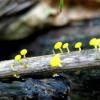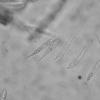
24-12-2025 17:08
Hulda Caroline HolteHello, I have found this propoloid ascomycete on

21-12-2025 09:32
Hello.A tiny ascomycete found embedded in wood in

21-12-2025 21:32
Pol DebaenstHello, Garden, Burgweg 19, Veurne, BelgiumOn 10/1

22-12-2025 23:38
Patrice TANCHAUDBonsoir, récolte sur un mur en pierre, apothéci

22-12-2025 00:47
Patrice TANCHAUDBonsoir, récolte à proximité du milieu dunaire
Disc yellowish, up to 2 mm., stalk whitish, smooth and slender.
Asci 142-160 x 12.8-14.4 microns, IKI+.
Ascospores 40-48.7 x 4.5-5.8 microns.
Paraphyses filled with refractive contents.
Ectal excipulum, parallel, thick-wall, gelatinous hyphae.
Is this a Crocireas?
I couldn't identify by Carpenter's monograph.
Best wishes,
Kutsuna

This is certainly a Hymenoscyphus in which the excipular cells are also somewhat gelatinized. Such strongly heteropolar spores are unknown in Crocicreas or Cyathicula.
This find is interesting, it reminds me of the N-American Hymenoscyphus dearnessii, a variant of which is known from Europe, here exclusively on Fallopia (Reynoutria). But the spores are not as big as you say, also they should have bristles at the ends.
Have you more microphotos? Ascus croziers? In which part of thw wordl did you collect, and what could the substrate be?
Zotto
Thank you for your reply.
This disco collected in bush near beech forest, Tottori, Japan, 22.Sept.2012.
Substrate uncertain herbaceous stem, I think Polygonaceae.
I have no more microphotos, but I couldn't observe coriziers and bristles.
Kutsuna

Yu et al. 2000, Mycotaxon 75: 395-408
This sounds like a new species.
Zotto
Kutsuna


 0401b-0001.jpg
0401b-0001.jpg